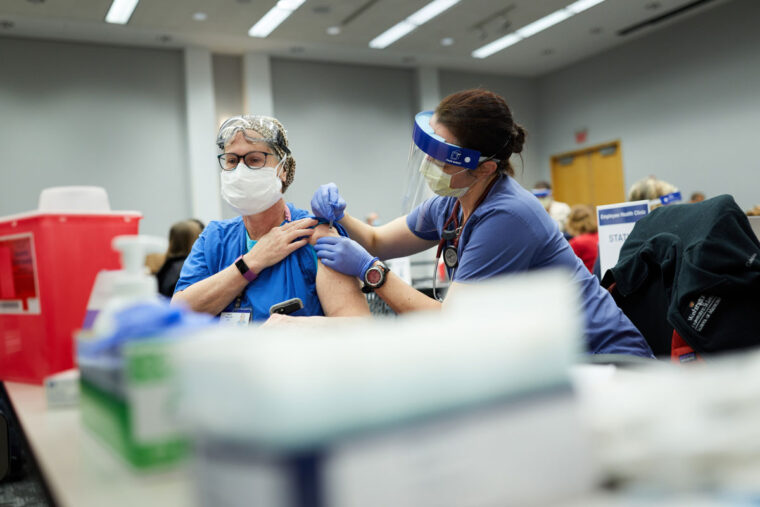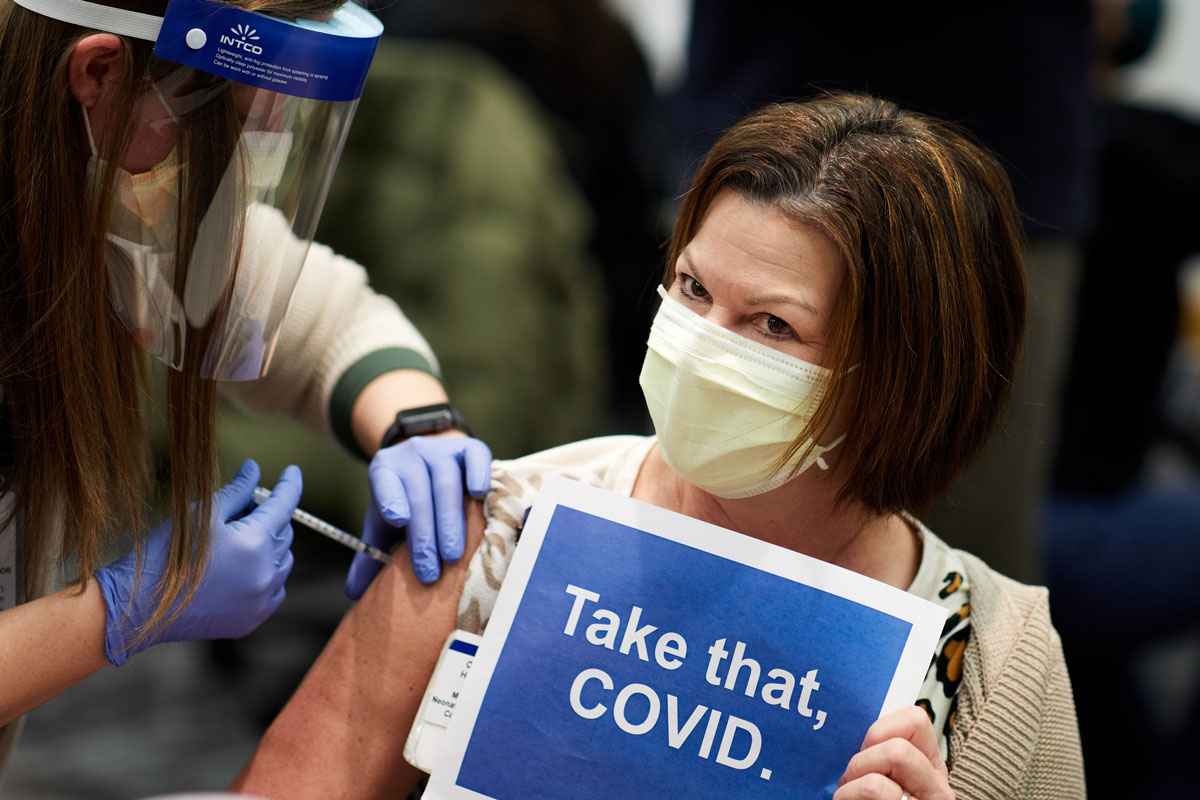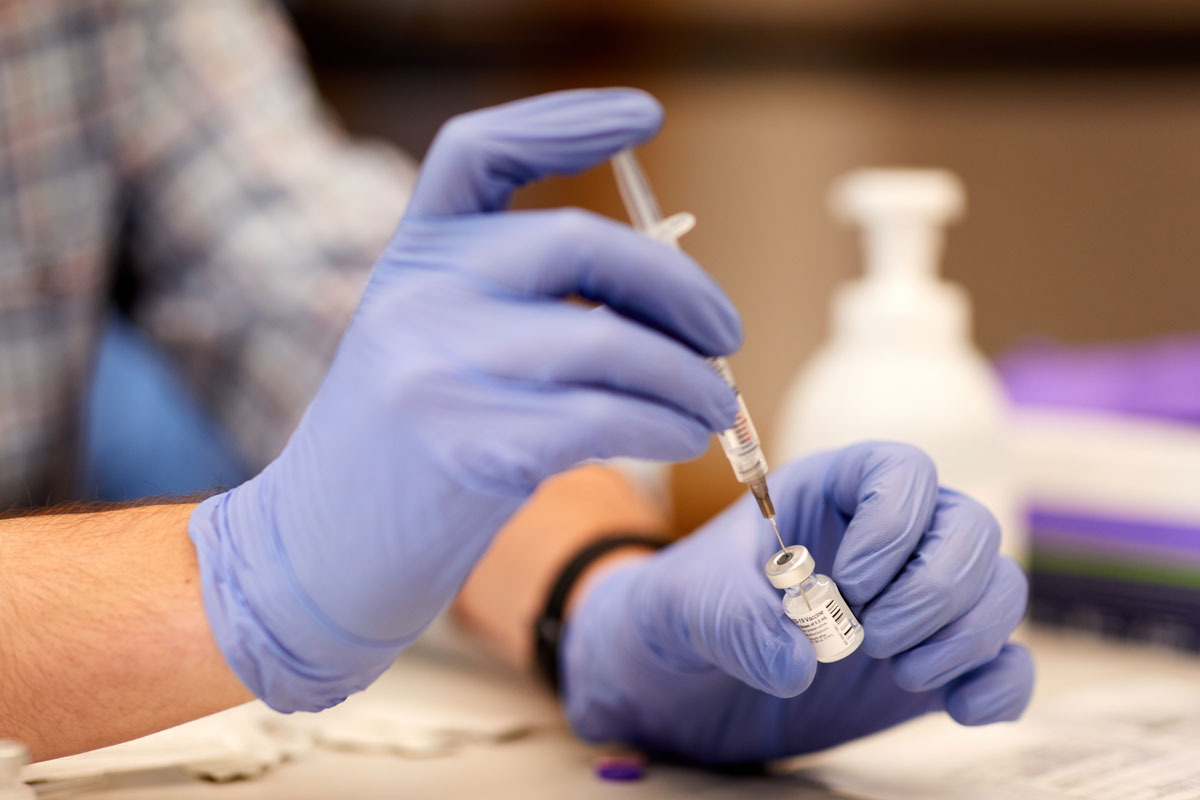
As part of a historic effort to end the COVID-19 pandemic, health-care personnel at Washington University School of Medicine in St. Louis and BJC HealthCare have begun receiving the first doses of a vaccine against the SARS-CoV-2 virus. Almost 10,000 doses of the Pfizer vaccine will be administered in the coming weeks to School of Medicine and BJC employees who have direct contact with patients, work in patient-care areas or handle potentially infectious materials, such as nasal swab samples. Such patient-facing personnel have been prioritized by the Centers for Disease Control and Prevention (CDC) and the state of Missouri to receive the vaccine first.
"We are thankful that it is now possible to offer a safe and effective SARS-CoV-2 vaccine to our front-line personnel," said David H. Perlmutter, MD, executive vice chancellor for medical affairs, the George and Carol Bauer Dean of the School of Medicine, and the Spencer T. and Ann W. Olin Distinguished Professor. "Our health-care workforce has drawn from a deep well of purpose and perseverance to take care of patients with COVID-19 and allow our hospitals and clinics to provide for the community under the most incredibly trying of circumstances."
The Food and Drug Administration (FDA) issued an emergency use authorization for the Pfizer/BioNTech vaccine Dec. 11. Vaccinations on the Medical Campus began with a practice run-through Dec. 16, during which five people received the vaccine. The large-scale effort kicked off Dec. 17, with some 420 people receiving the vaccine. BJC will continue to receive additional Pfizer vaccine orders in the coming weeks. The vaccine requires two doses, with the second dose given 21 days after the first.
BJC HealthCare is among the first health-care providers in Missouri and the bi-state region to receive shipments of the vaccine designated for patient-facing workers. However, the first shipment of vaccines will not cover all employees. Because the risk of severe COVID-19 increases with age, vaccine recipients will be prioritized by age, with older groups receiving the vaccine earlier than their younger counterparts.
Prioritized for the first round of vaccines are front-line personnel who work with patients or in close proximity to patients, even if they don't provide patient care. For example, food-service workers who deliver meals to patients, staff who clean patients' rooms, and lab personnel who handle patient samples will be as likely as doctors, nurses or respiratory therapists to receive the first round of vaccines.

"With the arrival of the vaccine this week, and the promise of others on the horizon, we're witnessing the beginning of the end to this pandemic," said Hilary M. Babcock, MD, professor of medicine and medical director of the BJC Infection Prevention and Epidemiology Consortium. "This a historic moment that brings us hope and makes me deeply grateful for the scientists who have worked so diligently to develop these vaccines, the public health professionals working to get the vaccines distributed, and the health-care workers who've fought so hard to take care of so many of us.
"The CDC, their advisory committees and the states developed guidelines to prioritize how to administer these vaccines so it is done accessibly, equitably and fairly," she said. "After high-priority personnel of all ages have been offered the opportunity to be vaccinated, we will move to other BJC or WUSM staff who work on the Medical Campus but do not, as part of their jobs, come into regular contact with patients or infectious material. As of now, staff able to work remotely will not be offered vaccine until later in the state's distribution plan."
The excitement was palpable early Dec. 17 as health-care workers gathered around registered nurse Jennifer Reneau, manager of occupational health at the School of Medicine, to go over steps on how to give the vaccine. "This," Reneau told the group, "is what hope looks like."
Among those to receive the vaccine Dec. 17 was Tyrone Simpkins, a sergeant with BJC security. Receiving the shot brought forth a swell of emotions for him.
"I've lost 12 family members to COVID this year," Simpkins said. "I'm going to stop it in my family. … Masks are great, but we've got to do something else, and now that we've got the vaccine, everybody should be trying to get it."
Critical care physician Tiffany Osborn, MD, professor of surgery and of emergency medicine, cheered after receiving her shot. "I am so excited about this vaccine being available," said Osborn, who treats patients at Barnes-Jewish Hospital. "I am so happy that we had this opportunity. This means so much for front-line workers. … Just knowing that you have that extra protection is such a godsend."
Joan Niehoff, MD, associate professor of anesthesiology, said that after months of being afraid of the virus and watching people suffer through illness, she felt euphoric after receiving the vaccine. "When I got the shot, I cried," said Niehoff, who treats patients at St. Louis Children's Hospital.
"I got the vaccine to protect myself and to protect the community," she explained. "This is the only way that we're going to get this pandemic to end. This is the only way. … Thank God for science."







